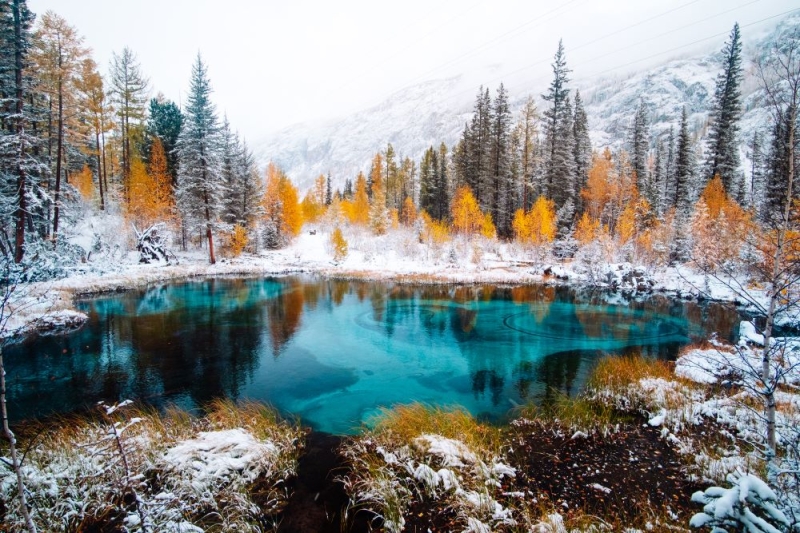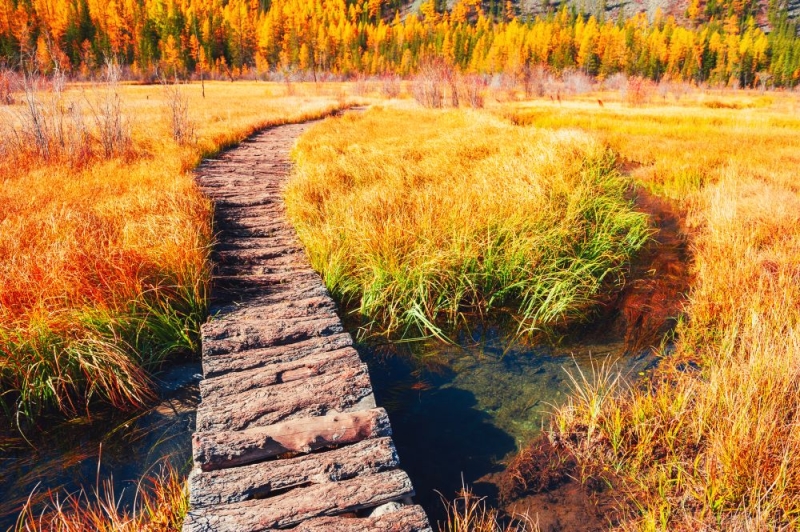
Altai is traditionally considered a spring-summer destination. Blooming herbs, campsites with tents, multi-day treks, and also an abundance of souvenir shops and queues for natural attractions. This is how the region most often appears at this time of year.
In December, the winter season opens in the mountains. Snow-capped Altai is not inferior to the Alps in terms of natural beauty and mild climate. At this time, recreation centers are filled to capacity, and the queues for the ski lifts in popular complexes can be compared with Rosa Khutor.
But there is another amazing season in this region, when the birch trees and soft larch needles on the hillsides turn yellow, in the morning gray frost glistens on the grass in the valleys, and the waters of mountain rivers become especially clear. This is how autumn comes to Altai. Guest houses are emptying, and air tickets from Moscow to Gorno-Altaisk can be bought for only 8,000 rubles* one way.
At this time the region is no less beautiful. We tell you where to go during the tourist “off season” in the selection.

The farthest point from Gorno-Altaisk is Tarkhata megalithic complex. It is located just 70 km from the state border with Mongolia (turn from the Chuisky tract in the area of the Kosh-Agach settlement at 49.9958598, 88.6655867) on the Ukok plateau. This ancient archaeological complex is also called the “Altai Stonehenge” and is attributed to either Scythian or extraterrestrial origin. The indigenous people call this area the edge of the earth or the border with the heavenly world and revere it as a sacred zone. The megaliths here are oriented toward astronomical objects, so scientists have suggested that the complex served as an observatory for ancient people.

Even if the idea of traveling almost 500 km from Gorno-Altaisk for the sake of a pile of stones seems dubious, you still need to get here at least for the fantastic views. Mountain ranges that catch the clouds, enchanting sunsets, snow caps that intricately refract daylight on the horizon, and an indescribably beautiful starry sky. If I were offered the opportunity to set up my own observatory, I would probably found it here.

Kyzyl-chin(nine km southwest of the village of Chagan-Uzun, turn from the Chuysky tract at approximately 50.1011841, 88.3723320) are called the rainbow mountains of Altai and are most often compared with the Peruvian Cusco. The Russian version, I’ll warn you right away, looks less varied in color – mainly shades of red, yellow and brown predominate there, with bluish-violet and almost black areas of the rock. But in terms of scale and beauty of the scenery in the background, “Martian Landscapes” of Altai is far ahead. True, in order to appreciate this and fully enjoy the views, you will have to climb quite high in your car, or, if we are talking about a passenger car, leave the car in the parking lot and walk along the path. It is clearly visible, so you won’t get lost!

In this part of the republic, the change of seasons is least noticeable due to the fact that there is little vegetation. The sky is the best indication of the approaching cold weather here. If you want to see a real mountain autumn, then in the village of Aktash you need turn north (50.3090179, 87.5991804) and follow the dirt road towards Lake Teletskoye. When you leave the vicinity of a populated area, the connection disappears. Now she will only meet in small settlements every one and a half to two hours. The road you are about to travel is popular with tourists, extremely picturesque and well traveled. True, this does not stop it from being a typical dirt road: with characteristic potholes, washouts and traces of grader tracks, which make traveling along it similar to sledding along the steps.

The first thing you come across on your way is Red Gate (50.3647855, 87.6337117). The rocks hang here over the bend of the road, really creating the impression of a passage, and nearby, below, the Chibitka river seethes and hisses. In cloudy weather it is quite ominous, but tourists love to stop and take pictures in this place: the spontaneous parking lot is full of cars at any time of the day.

Further along the way there are many lakes, but beyond the Ulagan Pass a real fashion model among the Altai lakes opens before your eyes – the small Lake Kidelyu (50.4998255, 87.6503353). Tiny by local standards, measuring only 400 by 150 meters, surrounded by coniferous and deciduous trees, this lake reflects the Kuraisky ridge in its mirror-like surface and, in my personal rating, is the best place for photographs in Altai.
The entire subsequent journey to the Katu-Yaryk pass, a decent tourist should look at the postcard views, spread over 360 degrees, and say “how great it is that we came here!”.

When you overcome Katu-Yaryk and leave the area of the surrounding tourist centers, you find yourself in the deserted valley of the Chulyshman River. I am not afraid to call the road through the valley one of the most beautiful routes in Russia. The goals of our trip are located about 50 km from the pass, which means that there is about an hour and a half of travel along a rapid blue river, past waterfalls on steep cliffs and between giant boulders falling from a height…

The dirt road leads to the southern branch of Lake Teletskoye, but along the way there are at least two more places that are definitely worth seeing. We are talking, firstly, about Akkurum tract(51.1094409, 87.9759809) or “Stone Mushrooms” – oddly shaped rocks on the mountainside. According to Altai legend, these mushrooms were sowed by the first man on Earth. Locals believe that when the last rock falls, the world will end. It sounds creepy, but when folklore was good-natured? To visit the tract, you need to cross the river. Enterprising locals with motorized water transport help tourists with this. The journey on water takes 30 seconds. Then you need to walk up the mountain path for another hour. It’s quite hard, but the view is definitely worth it!

Nearby is another interesting but hard-to-reach tourist spot: Big Chulchinsky Waterfall, better known as Uchar (51.1171670, 88.0906702). The cascade waterfall is considered the largest in Altai, although it does not have a classic appearance: the water does not rush down in a stream from a height, but rushes down the stone ledges with an incessant roar. The total height of the water fall is about 160 meters. In autumn, the waterfall is not so full of water, but surrounded by pine and yellowed deciduous trees, it is no less beautiful.
The path from the nearest base to the waterfall is nine km, so it is better to set aside a whole day for the hike to it. Experienced tourists can easily get to the waterfall on their own, but for beginners it’s safer to take a guide or go with a group.

Autumn Altai amazes with its beauty no less than in other seasons: green cedars, golden larches, turquoise Katun and mountain lakes of a thick lead color – a riot of colors is almost stronger than in spring and summer. At this time of year there are few tourists here, and the holiday becomes measured and calm. True, it is worth making allowances for the weather: in the fall it is much cooler in the mountains and cloudy days occur more often. But if you take the risk, be prepared to fall in love with autumn Altai forever!
*Prices valid at time of publication

